Resistors are conductive devices that exhibit resistance. Remember from Ohm’s Law that resistance is Voltage over Current and that resistance has units of Ohms. R = V / I. Resistors do not introduce any time lag between voltage and current, changes in one cause changes in the other instantaneously. The circuit symbol for a resistor is below.
Resistor Symbol

Common Resistor Equations
| Voltage = Current * Resistance (Ohm’s Law) | |
| Power = Voltage * Current | |
| Power = Current Squared Times Resistance | |
| Power = Voltage Squared Divided by Resistance |
The above equations should be memorized. These are used all the time in EE school and on the job.
Key Specifications of Real Resistors
- Resistance – nominal resistance
- Tolerance – accuracy of resistance
- Maximum Power
Real world resistors come in a wide range of values and their limiting specification for most applications is their power rating. The power rating is based on how much heat the device can safely dissipate, so it is really the average power dissipated by the resistor over some timeframe relating to its thermal mass that is the concern, not the instantaneous power dissipation. When implementing a resistor it is typically the power rating that determines which type and size of resistor you select.
Another important specification of real world resistors is their tolerance (accuracy of resistance value), and common tolerances are .1%, 1%, and 5%. Nowadays, 1% resistors are pretty much the same cost as 5%, so may make sense to just use 1% tolerance parts for general purpose. .1% parts are more expensive and may be more difficult to find, so just use those when you need the increased accuracy. Tolerance rating means that the resistance will remain within that tolerance of the nominal value across the rated temperature range for the rated life of the resistor. For example, a 5% 100 Ohm resistor will have resistance in the range of 95-105 Ohms.
There are standard values of resistors, and the available standard values are different for each tolerance type. Definitely go with standard values as much as possible, because non standard values will be more expensive and more difficult to acquire. Tables for standard values are provided towards the bottom of this page.
Types of Resistors
Fixed Resistors
Through-Hole Axial:
There are several types such as carbon composition, thin film, and thick film. Good for breadboarding.

Wirewound:
– Used for high power rating up to 100W or more.
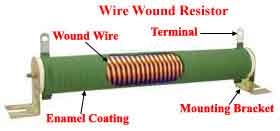
Surface Mount:
– Small size, lowest cost, cheap to assemble too.
– Primary choice for circuit board designs.
– Required for high frequency applications due to small size. Also works fine for low frequency and DC.
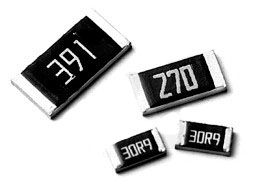
Variable Resistors
Potentiometer:
– Resistance varies with manual adjustment

NTC Thermistor:
– Negative Temperature Coefficient (NTC) – resistance decreases as temperature increases.
– Often used to measure temperature
– Often used as inrush current limiters – inrush current is the current at power on that initially charges up capacitors.
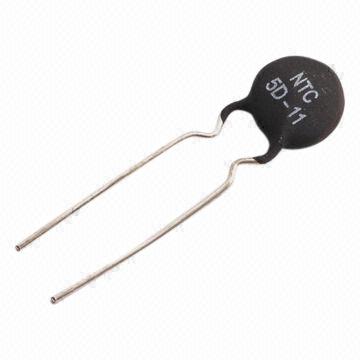
PTC Thermistor:
– Positive Temperature Coefficient (PTC) – resistance increases as temperature increases
– Often used as resettable fuses. When current increases beyond a threshold, the device starts heating up, which increases resistance, which causes more power dissipation (heating), which increases resistance, and in short order the resistance gets very high, which shuts off current. After the device cools off, it goes back to low resistance.
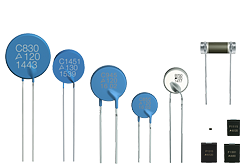
Surface Mount Resistor Packages
Surface Mount device (SMD) resistors come in standardized package sizes that have standardized maximum power ratings. Each size has a different power rating as shown in the table below.
SMD Resistor Power Ratings
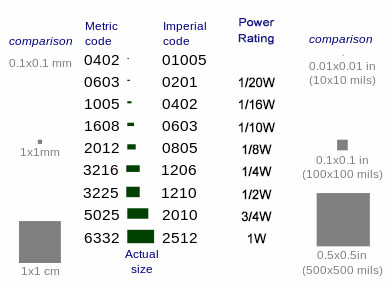
On this website I will refer to Imperial Code sizes, since that is what I am familiar with. 01005 and 0201 resistors are for ultra-small electronics like cell phones. These are so small that they cannot be reworked by hand, except by rare individuals. 0402 and 0603 are the most commonly used sizes and are the least expensive. Larger package sizes are for use when you need increased power rating.
Standard Resistor Values
1% Tolerance Standard Values
Decade multiples of the below values are available from milli-Ohms to Mega-Ohms.
| 10.0 | 10.2 | 10.5 | 10.7 | 11.0 | 11.3 | 11.5 | 11.8 | 12.1 | 12.4 | 12.7 | 13.0 |
| 13.3 | 13.7 | 14.0 | 14.3 | 14.7 | 15.0 | 15.4 | 15.8 | 16.2 | 16.5 | 16.9 | 17.4 |
| 17.8 | 18.2 | 18.7 | 19.1 | 19.6 | 20.0 | 20.5 | 21.0 | 21.5 | 22.1 | 22.6 | 23.2 |
| 23.7 | 24.3 | 24.9 | 25.5 | 26.1 | 26.7 | 27.4 | 28.0 | 28.7 | 29.4 | 30.1 | 30.9 |
| 31.6 | 32.4 | 33.2 | 34.0 | 34.8 | 35.7 | 36.5 | 37.4 | 38.3 | 39.2 | 40.2 | 41.2 |
| 42.2 | 43.2 | 44.2 | 45.3 | 46.4 | 47.5 | 48.7 | 49.9 | 51.1 | 52.3 | 53.6 | 54.9 |
| 56.2 | 57.6 | 59.0 | 60.4 | 61.9 | 63.4 | 64.9 | 66.5 | 68.1 | 69.8 | 71.5 | 73.2 |
| 75.0 | 76.8 | 78.7 | 80.6 | 82.5 | 84.5 | 86.6 | 88.7 | 90.9 | 93.1 | 95.3 | 97.6 |
5% Standard Values
Decade multiples of the below values are available from milli-Ohms to Mega-Ohms. For example, 820, 8.2, and 8.2k are all available.
| 10 | 11 | 12 | 13 | 15 | 16 | 18 | 20 | 22 | 24 | 27 | 30 |
| 33 | 36 | 39 | 43 | 47 | 51 | 56 | 62 | 68 | 75 | 82 | 91 |
Here is a video from ResistorGuide.com on Youtube that provides an excellent discussion of resistors.
Next: Capacitors
